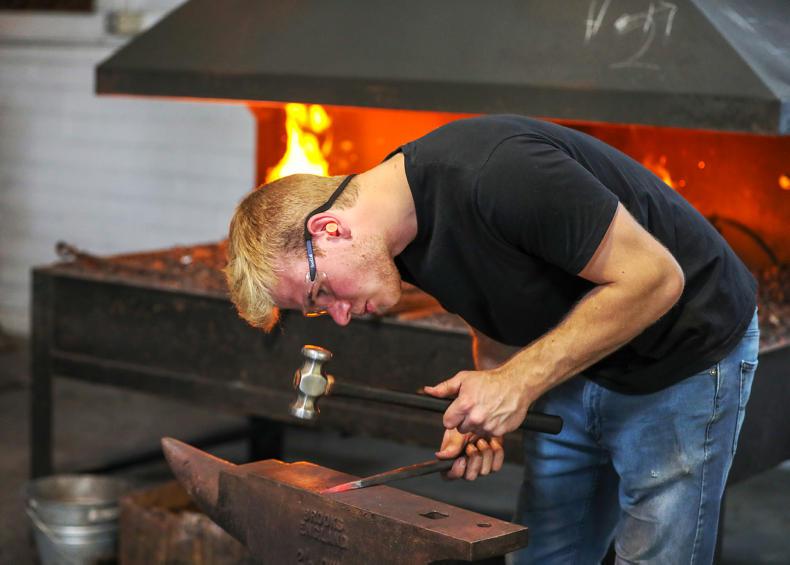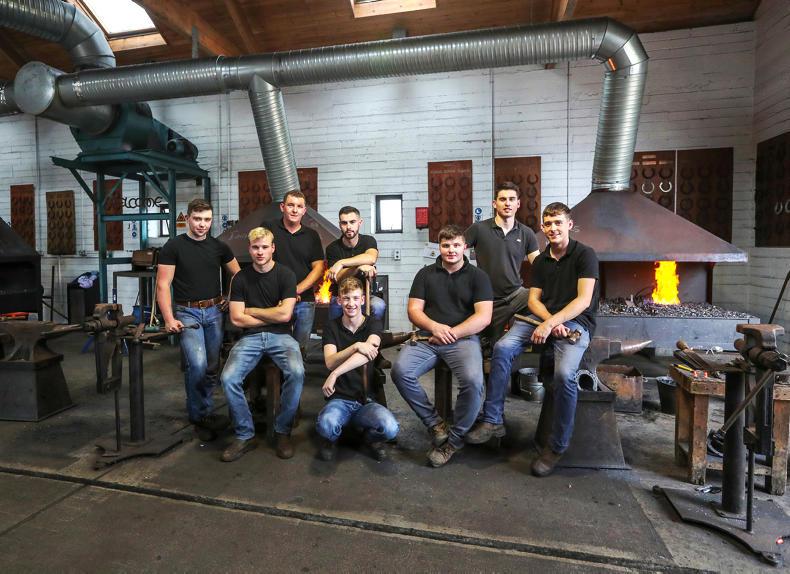‘NO hoof, no horse’ is very true but it is also important to remember ‘No farrier, no hoof’. Farriers are an essential part of the team for every horse, regardless of the discipline and the level, and the role played by farriers should not be underestimated.
Run under the Irish Farrier Authority, the Irish School of Farriery is where Irish farriers learn their trade. The school is now one of the most highly regarded farrier schools in the world, with graduates working around the world and a network on connections the school has a very global outlook.
Training to become a farrier not only helps to maintain and develop the standard and quality of farriers around Ireland, it also offers graduates a license to travel. The Irish School of Farriery prepares graduates to work in any environment around the world. This was evident last year when three quarters of the graduates went abroad to work.
Established in 2003 and based at the RACE Campus in Kildare the school offers a QQI Level 6 Advanced Certificate Craft in Farriery.
The course is very practical and is always changing to keep up with the demands of the industry. In order to enter the course students or apprentice farriers must be 16 years old or over, and they must be employed by a Master Farrier who is approved by the school before they begin the course.

Course overview
The minimum duration of the course is four years and two months. The course is run over seven phases, four phases consist of the apprentice farriers working with their Master Farrier and the remaining three phases are spent in the school learning new skills and expanding their knowledge.
Each apprentice gains experience in the working environment and learn various aspects of job while they are with their Master Farrier. This is an essential part of their training and they are assessed throughout each phase with their Master Farrier.
In order to progress to the next phase each apprentice must pass their assessment at the end of the previous phase – if they fail to do so they have to repeat each assessment, adding to the length of time it takes to complete the course.
The course begins with the apprentices doing their first work placement with their Master Farrier. In phase two the apprentices come into the school for 20 weeks. During this period they learn a number of the basic skills.
Modules in phases two:

Jack O’Malley \ carolinenorris.ie
After phase two is complete the apprentices go back and complete another work placement with their Master Farrier. Each period of work placement includes work based training and assessments.
Phase four is a 10-week period where the apprentices are back in the school. During this phase they expand their knowledge on modules covered in phase two and learn new skills.
Modules in phase four:
 Once again this phase is followed by a phase of work placement before the apprentices return for phase six – their final 10-week period in the school.
Once again this phase is followed by a phase of work placement before the apprentices return for phase six – their final 10-week period in the school.
The final phase is another work placement with their master farrier.
Modules in phase six:
All of the modules completed in the school are taught by farriers or industry experts, this adds a unique and very practical element to the course. Like most third level institutions, different instructors teach different modules.
The instructors also work closely together in order to link modules together and give the apprentices a complete view of what they are studying. From talking to the apprentices it is clear how much they all value the instructors and individual experience each instructor brings to the course.
Throughout all of the course there is a focus of learning through practical, hands-on experience. When the apprentices are in the school they spend their time between the forge and the classroom. Modules such as forgework and shoe-making are primarily based in the forge, which has all of the necessary equipment and a specially designed area to safely shoe live horses. The remainder of their time is spent in the classroom.
All of the classroom lectures are designed to fit in with what the apprentices are learning in the forge and what they are learning while they are with their respective Master Farriers, so that they can see the importance and need to understand different topics.
One topic covered at the Irish School of Farriery which is not widely covered in other farrier schools is the use of modern materials. All of the apprentices at the school learn how to use alternative methods and new techniques. This is one of the many aspects of the course which is kept very current and the apprentice farriers are often at the forefront of learning and developing new methods.
The course also covers all aspects of running a business and prides itself on teaching the apprentices about the business and economical side of being a farrier as well as the skills to make and put on shoes correctly. Through different modules the apprentices learn about looking after the taxes and getting the correct insurance as well as understanding their business model.
The apprentices expressed how helpful they find these elements of the course and how they think it will strongly benefit them in the future.

Eoin O’Connell \ carolinenorris.ie
Focus on communication
Communication is one of the most important aspects of the course. Alwyn McKeown is one of the instructors at the school and he explained how it is almost as important that the apprentices are able to talk and communicate with owners as it is that they can put on a good set of shoes.
He went on to add: “That farriers often have to work closely with veterinary surgeons and in many cases they have to explain what the veterinary surgeon is saying to the owner.”
In order to help the apprentices improve their communication skills they are required the give various presentations throughout the course. These presentations also act as a bridge between the classroom elements of the course and the practical work. Presentations are usually made in front of instructors and the other apprentices, but in some cases the apprentice’s Master Farrier may come along as well.
For instance the apprentices may have to present on a topic which requires them to show their understanding of the issue, how this effects the horse, and what farrier work is required to correct the issue.
As the apprentices progress through the course the need for good communication skills in emphasised.
Towards the end of the course each apprentice has to assess a horse, create a shoeing programme for that horse and implement the programme. During this the apprentices must communication their objectives and process.

Apprentice profiles
Ben McAteer
Age: 20
Ben comes from a family of farriers, and when he qualifies he will become the sixth farrier in the family. From an early age Ben knew he wanted to work outside, he completed his Leaving Certificate but decided that college wasn’t the best path for him.
Becoming a farrier was the obvious choice – having grown up around horses and with a good understanding of the profession from his family, it was a perfect fit.
When asked about why he chose this career path he simply said: “I love it.” Ben went on to add that he enjoys how no two days are ever the same and that he loves working outside and with different clients everyday.
Ben is currently training under his father Michael McAteer and also under his cousin John McAteer, both of whom are master farriers based in Co Meath.
Ben considers himself very lucky that the family has a large base of clients built up already and one day he hopes to join in the family business. However, he is considering travelling when he graduates and then coming back to Ireland.
Jerry Skelton
Age: 19
Jerry has been around horses for as long as he can remember. His family have always had an interest in sport horses and he grew up helping to prepare horses for the sales and producing young horses.
However, Jerry has become more involved in the thoroughbred industry in recent years. He worked breaking and backing point-to-point horses and he also rode out racehorses when he finished school.
When he qualifes Jerry will become the second farrier in his family – his brother is already a farrier and he hopes that in the future they might work together. In the meantime, Jerry is planning to go abroad for a couple of years after graduating, although he added that he “could never stay for good.”
Jerry spoke very highly about the Irish School of Farriery and about the course. He said: “It’s a very good course. All of the instructors are very good and have the experience.”
Brian O’Reilly
Age: 19
Brian spent some time riding out but decided it wasn’t for him, he felt he needed a more reliable and consistent career which led him to becoming a farrier. He is currently completing his apprenticeship under master farrier Brian Horohoe in Longford.
Like the other apprentices, Brian is strongly considering working abroad when he graduates, and at the moment America and Dubai are on the top of his list.
Brian is thoroughly enjoying the course and he explained why, saying: “It has a very good balance and it is very relatable. Everything you learn you can relate to a problem or situation.”
“It’s easy when you enjoy it,” he added. The relationship between the instructors and the apprentices is very important and is something which Brian noted as one of the best aspects of the course. “All of the instructors are very understanding, they’ll work with you on what you’re not good at.” The willingness from the instructors and the ability to give each apprentice the time they need is something which really sets the school apart.
Brian also noted how every aspect of being a farrier is addressed in the course. He feels that being a farrier is about 55% communications and 45% farrier work. He also noted the importance of showing horses and owners respect and appreciation.
Contact details
Phone: +353 45 520765
Email: info@irishfarrieryauthority.com
